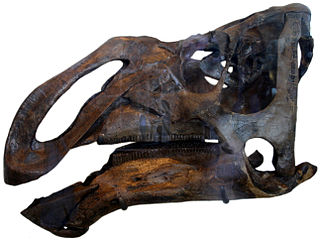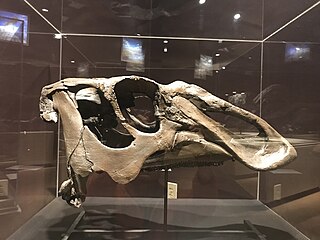Related Research Articles

Kritosaurus is an incompletely known genus of hadrosaurid (duck-billed) dinosaur. It lived about 74.5-66 million years ago, in the Late Cretaceous of North America. The name means "separated lizard", but is often mistranslated as "noble lizard" in reference to the presumed "Roman nose".

Aetosaurs are heavily armored reptiles belonging to the extinct order Aetosauria. They were medium- to large-sized omnivorous or herbivorous pseudosuchians, part of the branch of archosaurs more closely related to crocodilians than to birds and other dinosaurs. All known aetosaurs are restricted to the Late Triassic, and in some strata from this time they are among the most abundant fossil vertebrates. They have small heads, upturned snouts, erect limbs, and a body ornamented with four rows of plate-like osteoderms. Aetosaur fossil remains are known from Europe, North and South America, parts of Africa, and India. Since their armoured plates are often preserved and are abundant in certain localities, aetosaurs serve as important Late Triassic tetrapod index fossils. Many aetosaurs had wide geographic ranges, but their stratigraphic ranges were relatively short. Therefore, the presence of particular aetosaurs can accurately date a site in which they are found.

Anasazisaurus is a genus of saurolophine hadrosaurid ("duckbill") ornithopod dinosaur that lived about 74 million years ago, in the Late Cretaceous Period. It was found in the Farmington Member of the Kirtland Formation, in the San Juan Basin of New Mexico, United States. Only a partial skull has been found to date. It was first described as a specimen of Kritosaurus by Jack Horner, and has been intertwined with Kritosaurus since its description. It is known for its short nasal crest, which stuck out above and between its eyes for a short distance.

Stegopelta is a genus of struthiosaurin nodosaurid dinosaur. It is based on a partial skeleton from the latest Albian-earliest Cenomanian-age Lower and Upper Cretaceous Belle Fourche Member of the Frontier Formation of Fremont County, Wyoming, USA.

The Glen Canyon Group is a geologic group of formations that is spread across the U.S. states of Nevada, Utah, northern Arizona, north west New Mexico and western Colorado. It is called the Glen Canyon Sandstone in the Green River Basin of Colorado and Utah.
Spinosuchus is an extinct genus of trilophosaurid allokotosaur from the Late Triassic of Texas, southern United States. It has been assigned to a variety of groups over its history, from coelophysid dinosaur to pseudosuchian to uncertain theropod dinosaur and to Proterosuchidae. This uncertainty is not unusual, given that it was only known from a poorly preserved, wall-mounted, partial vertebral column of an animal that lived in a time of diverse, poorly known reptile groups. However, newly collected material and recent phylogenetic studies of early archosauromorphs suggest that it represents an advanced trilophosaurid very closely related to Trilophosaurus.

Glyptodontopelta is a monospecific genus of nodosaurid dinosaur from New Mexico that lived during the Late Cretaceous in what is now the Naashoibito member of the Ojo Alamo Formation. The type and only species, Glyptodontopelta mimus, is known from numerous specimens that consist of osteoderms, a dentary, supraorbital and bone fragments. It was named in 2000 by Tracy Ford. Edmontonia australis is a junior synonym of Glyptodontopelta.

The Wingate Sandstone is a geologic formation in the Glen Canyon Group of the Colorado Plateau province of the United States which crops out in northern Arizona, northwest Colorado, Nevada, and Utah.

Naashoibitosaurus is a genus of hadrosaurid dinosaur that lived about 73 million years ago, in the Late Cretaceous, and was found in the Kirtland Formation of the San Juan Basin in New Mexico, United States. Only a partial skeleton has been found to date. It was first described as a specimen of Kritosaurus by Jack Horner, and has been intertwined with Kritosaurus since its description.

The Kirtland Formation is a sedimentary geological formation.

Trilophosaurus is a lizard-like trilophosaurid allokotosaur known from the Late Triassic of North America. It was a herbivore up to 2.5 m long. It had a short, unusually heavily built skull, equipped with massive, broad flattened cheek teeth with sharp shearing surfaces for cutting up tough plant material. Teeth are absent from the premaxilla and front of the lower jaw, which in life were probably equipped with a horny beak.

The Arundel Formation, also known as the Arundel Clay, is a clay-rich sedimentary rock formation, within the Potomac Group, found in Maryland of the United States of America. It is of Aptian age. This rock unit had been economically important as a source of iron ore, but is now more notable for its dinosaur fossils. It consists of clay lenses within depressions in the upper part of the Patuxent Formation that may represent oxbow swamp facies. It is named for Anne Arundel County, Maryland.
Paleontology or palaeontology is the study of prehistoric life forms on Earth through the examination of plant and animal fossils. This includes the study of body fossils, tracks (ichnites), burrows, cast-off parts, fossilised feces (coprolites), palynomorphs and chemical residues. Because humans have encountered fossils for millennia, paleontology has a long history both before and after becoming formalized as a science. This article records significant discoveries and events related to paleontology that occurred or were published in the year 1998.
Tecovasuchus is an extinct genus of aetosaur. It is known primarily from osteoderms found from the Tecovas Formation in Texas, which is Late Triassic in age, dating back to the lower Norian. Material is also known from several other localities of the Chinle Group in New Mexico and Arizona, such as older Carnian outcrops and younger Rhaetian outcrops. Specimens of Tecovasuchus have been collected from the Tecovas Formation, the Bluewater Creek Formation, and the Los Esteros Member of the Santa Rosa Formation.
The Packard Formation is a Mesozoic geologic formation. The formation may be from the Kirtlandian land vertebrate age. It has a similar fauna to the Corral de Enmedio Formation.

The Menefee Formation is a lower Campanian geologic formation found in Colorado and New Mexico, United States.

The Ojo Alamo Formation is a geologic formation in New Mexico spanning the Mesozoic/Cenozoic boundary. Non-avian dinosaur fossils have controversially been identified in beds of this formation dating from after the Cretaceous–Paleogene extinction event, but these have been explained as either misidentification of the beds in question or as reworked fossils, fossils eroded from older beds and redeposited in the younger beds.
Redondasuchus is an extinct genus of aetosaur. It may be a junior synonym of Typothorax coccinarum, another aetosaur. Redondasuchus is a member of the clade Typothoracisinae within the subfamily Aetosaurinae, and lived during the middle Norian stage of the Late Triassic. Material belonging to the genus has been found from the Redonda Formation in east-central New Mexico. The type species, R. reseri, was named in 1991 after having been referred to as a species of Typothorax since 1985. A second species, R. rineharti, was described in 2006.
The Colorado City Formation is a Late Triassic geologic formation in the Dockum Group of Texas, United States. It has previously been known as the Iatan Member, Colorado City Member or 'Pre-Tecovas Horizon'.

Menefeeceratops is a genus of ceratopsid dinosaur from the Menefee Formation in New Mexico, United States. It is potentially the oldest known member of the ceratopsids, as well as the centrosaurine subfamily, related to animals including Yehuecauhceratops and Crittendenceratops. The type and only species is Menefeeceratops sealeyi, known from a partial, non-articulated skeleton.
References
- ↑ "CSI - Articles by Chris Whittle". csicop.org. Retrieved September 14, 2010.
- ↑ Luna (tugboat)
- ↑ "Tugboat Luna - Boston Landmarks Commission Study Report" (PDF). www.cityofboston.gov. 1985-05-03. Retrieved 2024-06-22.
- ↑ "The Jefferson School - Faculty & Staff". jeffersonschool.com. Archived from the original on July 7, 2010. Retrieved November 1, 2010.
- ↑ "VisionQuest: Morning Star Youth Academy". Archived from the original on 2012-12-09. Retrieved 2012-02-01.